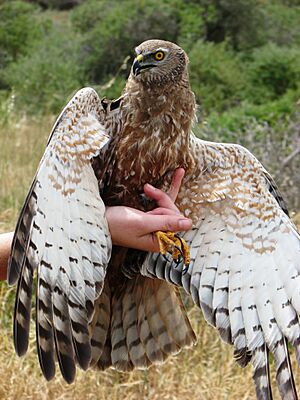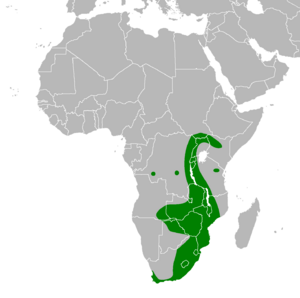African marsh harrier facts for kids
Quick facts for kids African marsh harrier |
|
|---|---|
 |
|
| Conservation status | |
| Scientific classification | |
| Genus: |
Circus
|
| Species: |
ranivorus
|
 |
|
The African marsh harrier (Circus ranivorus) is a cool bird of prey that belongs to the harrier family. These birds are mostly found in wet areas like marshes and swamps across southern, central, and eastern Africa. You can spot them from South Africa all the way up to South Sudan.
Contents
Meet the African Marsh Harrier

Female African marsh harriers are bigger than males. They are about 44–47 centimetres (17–19 in) long. Females can be about 30% heavier than males. Adult birds have bright yellow eyes. Young birds have brown eyes.
Both male and female harriers are mostly brown. They have pale stripes on their heads, chests, and the front part of their wings. Their thighs and bellies are a reddish-brown color. Adult males have a light grey color on their back feathers. Females keep their brown color. Young birds are dark brown. They might have a pale band on their chest. Their tails and flight feathers have dark stripes. These stripes are hard to see on young birds.
This harrier looks like a smaller Eurasian marsh harrier. But it is thinner and a lighter brown. You might confuse it with a young Montagu's harrier or pallid harrier. However, the African marsh harrier does not have a white rump (the lower back area). This helps you tell them apart.
These birds are usually quiet. The male has a high-pitched, two-note call during courtship. Only the female makes a loud pseeew-pseeew sound. This call is used when she wants food or during breeding.
Where Do They Live?
African marsh harriers usually live in marshes or areas with tall reeds. You can find them in eastern Africa. They hunt over open grasslands and farms near wet areas. They live from sea level up to 3,000 metres (9,800 ft) high. Most often, they are found above 1,500 metres (4,900 ft).
Where Can You Find Them?
The African marsh harrier mostly lives in the wetter parts of southern and eastern Africa. You can find them from the Western Cape in South Africa. Their range goes north through eastern South Africa, Lesotho, Eswatini, eastern Zimbabwe, and parts of Mozambique. They are also in Malawi, southwestern Tanzania, and western Zambia. You can see them in southeastern Angola and northern Botswana. The Okavango Delta in Botswana is a key spot. They are also in northeastern Namibia.
Some groups of these birds live in other areas. These include northern Tanzania, parts of the Democratic Republic of Congo, Rwanda, and southeastern Uganda. The northernmost groups are in northwestern Kenya, northern Uganda, and South Sudan.
What Do They Eat and How Do They Live?
The African marsh harrier eats many different things. Small mammals make up about 70% of their diet. They also eat adult birds, young birds, lizards, frogs, and large insects. Sometimes, they catch birds as big as a Red-billed teal or a speckled pigeon. Doves, especially laughing doves, are a favorite meal in some places.
African marsh harriers do not live in areas with less than 300 millimetres (12 in) of rain each year. This is because wetlands are rare in dry places. Their main food in southern Africa, the striped mouse (Rhabdomys pumilio), also needs more rain. They will even eat dead animals like flamingo bodies left by birds like African fish eagles. Most of their food is caught on the ground. But they often catch birds and insects while flying.
Unlike many other harriers, these birds stay with one partner. They also stay in their breeding area for most of the year. In the southern Cape, some birds leave for a few months after breeding. They return around May or June. The nest is usually built in a reedbed. It is sometimes built high above the water. They lay two to four white eggs from July to November. All eggs start with a blue tint. This helps tell new eggs apart.
African marsh harriers do not gather in large groups to sleep. They usually sleep alone. They leave their sleeping spot early in the morning. Then they fly slowly over the ground. They hunt like typical harriers. They usually fly less than 10 meters above the ground. They hunt over wetlands and nearby drier land.
Protecting the African Marsh Harrier
African marsh harriers are common in many wetlands in eastern and southern Africa. This is especially true in Uganda, Botswana, and Zambia. In South Africa, there are an estimated 3,000-6,000 pairs left. But some groups are getting smaller. The species is seen as endangered in that region.
Outside South Africa, there are still large areas of good habitat. Examples include the Okavango Delta in Botswana and much of Zambia. The species is still common in these local areas. Experts believe there are between 10,000 and 100,000 individuals in total.
Their numbers are going down for several reasons. Wetlands are being drained or dammed. Too many animals are grazing in their habitats. Human activity also disturbs them. It is also possible that pesticide poisoning is a problem.


